Embodied Experience and Visitor Loyalty in Historic Cultural Heritage Buildings: Integrating Structural Equation Modeling and Deep Learning
Abstract
1. Introduction
- (1)
- What are the core dimensions of embodied experience system design in historic cultural heritage buildings?
- (2)
- How does embodied experience system design influence visitor loyalty through mediating mechanisms such as restorative perception, flow experience, and cultural identity?
- (3)
- How can structural equation modeling (SEM) be used to construct and verify a model of the mechanism of embodied experience system design on visitor loyalty?
- (4)
- How can deep learning methods be employed to predict visitor loyalty and identify the key indicators of embodied experience?
2. Literature Review
2.1. Embodied Experience
- Physical Interaction captures direct bodily engagement with heritage objects or installations, transforming visitors from passive observers to active participants, which enhances control, efficacy, and emotional value [24].
- Spatial Embodiment emphasizes coherent spatial narratives and environmental organization, enabling visitors to experience a sense of place, historical continuity, and emotional flow [25].
- Situational Engagement and Social Interaction highlights co-creation through interactions with guides, community members, or other visitors, fostering belonging, cultural co-production, and willingness to recommend [20].
- Cultural Cognition and Emotional Connection reflects visitors’ understanding of heritage meaning, identity recognition, and emotional attachment, linking individual experiences to collective memory and loyalty behaviors [26].
- Technological Mediation involves the use of VR/AR, digital twins, or interactive systems to enhance accessibility, immersion, and comprehension without replacing the authenticity of heritage [27].
2.2. Visitors’ Loyalty
2.3. The Mediating Role of Environmental Restoration Perception
2.4. The Mediating Role of Flow Experience
2.5. The Moderating Role of Cultural Identity
3. Materials and Methods
3.1. Study Area
3.2. Research Method
3.2.1. Questionnaire Design
3.2.2. Data Collection
3.2.3. Data Analysis: Structural Equation Modeling
3.2.4. Deep Learning Prediction
4. Results
4.1. Reliability Analysis
4.2. Validation Factor Analysis
4.3. Mediating Effects of Environmental Restoration Perception and Flow Experience
4.4. Moderating Effect of Cultural Identity
4.5. Results of Deep Learning Prediction
4.5.1. Model Performance Comparison
4.5.2. Model Training and Convergence Performance
4.5.3. Predictive Accuracy of Models
4.5.4. Key Predictors of Visitor Loyalty
5. Discussion
5.1. Mediating Roles of Environmental Restoration and Flow Experience
5.2. Cultural Identity’s Role in Strengthening Visitor Loyalty
5.3. Predictive Insights from Deep Learning
6. Conclusions
Author Contributions
Funding
Conflicts of Interest
References
- Zhou, Z.; Syamsunur, D.; Fan, X.; Li, J. A Preliminary Investigation on the Relationship Between the Sustainable Construction Field and the Sustainable Development Goals: A Proposed Research Framework. In Proceedings of the E3S Web of Conferences, Yogyakarta, Indonesia, 7–8 August 2025; p. 03014. [Google Scholar]
- Haselberger, M.; Krist, G. Applied Conservation Practice Within a Living Heritage Site. Stud. Conserv. 2022, 67, 96–104. [Google Scholar] [CrossRef]
- Min, W. A scientometric review of cultural heritage management and sustainable development through evolutionary perspectives. npj Herit. Sci. 2025, 13, 215. [Google Scholar] [CrossRef]
- Liang, L.; Elliot, S. A systematic review of augmented reality tourism research: What is now and what is next? Tour. Hosp. Res. 2020, 21, 146735842094191. [Google Scholar] [CrossRef]
- Pinto, I.; Huertas, A. A comparative study of VR and AR heritage applications on visitor emotional experiences: A case study from a peripheral Spanish destination. Virtual Real. 2025, 29, 36. [Google Scholar] [CrossRef]
- Academy, C.T. Annual Report on China’s Domestic Tourism Development 2024; China Tourism Academy: Beijing, China, 2025.
- Chen, W.; Li, T.; Zhang, Y. Embodied cognition model for museum gamification cultural heritage communication a grounded theory study. npj Herit. Sci. 2025, 13, 239. [Google Scholar] [CrossRef]
- Lin, X.; Wang, Y.; Zhan, Z.; Wang, Q.; Xiang, D.; Li, H. Effects of VR technical interaction and acceptance on rural cultural identity: The mediating role of embodied cognition and flow experience. Telemat. Inform. Rep. 2024, 16, 100170. [Google Scholar] [CrossRef]
- Yang, W.; Chen, Q.; Huang, X.; Xie, M.; Guo, Q. How do aesthetics and tourist involvement influence cultural identity in heritage tourism? The mediating role of mental experience. Front. Psychol. 2022, 13, 990030. [Google Scholar] [CrossRef]
- Sancho Núñez, J.C.; Gómez-Pulido, J.A.; Ramírez, R. Machine learning applied to tourism: A systematic review. Wiley Interdiscip. Rev. Data Min. Knowl. Discov. 2024, 14, e1549. [Google Scholar] [CrossRef]
- Zhang, J.; Gao, M. The application of deep learning in economic analysis and marketing strategy formulation in the tourism industry. PLoS ONE 2025, 20, e0321992. [Google Scholar] [CrossRef]
- Şeker, F. Evolution of Machine Learning in Tourism: A Comprehensive Review of Seminal Research. J. Artif. Intell. Data Sci. 2023, 3, 54–79. [Google Scholar]
- Wu, K.; Guo, Y.; Han, X. The relationship research between restorative perception, local attachment and environmental responsible behavior of urban park recreationists. Heliyon 2024, 10, e35214. [Google Scholar] [CrossRef]
- López-Naranjo, A.L.; Puente-Riofrio, M.I.; Carrasco-Salazar, V.A.; Erazo-Rodríguez, J.D.; Buñay-Guisñan, P.A. Artificial intelligence in the tourism business: A systematic review. Front. Artif. Intell. 2025, 8, 1599391. [Google Scholar] [CrossRef]
- Jimenez-García, D.; Espinoza Heredia, O.; Cruz Lizana, E.; Cruz-Tarrillo, J.J.; Millones-Liza, D.Y. Destination Image and Brand Value as Predictors of Tourist Behavior: Happiness as a Mediating Link. Adm. Sci. 2025, 15, 176. [Google Scholar] [CrossRef]
- Song, H.; Chen, J.; Li, P. Decoding the cultural heritage tourism landscape and visitor crowding behavior from the multidimensional embodied perspective: Insights from Chinese classical gardens. Tour. Manag. 2025, 110, 105180. [Google Scholar] [CrossRef]
- Smith, L. Uses of Heritage. In Uses Herit; Routledge: New York, NY, USA, 2006; pp. 1–351. [Google Scholar] [CrossRef]
- Waterton, E.; Watson, S. The Palgrave Handbook of Contemporary Heritage Research; Springer: New York, NY, USA, 2015; pp. 1–560. [Google Scholar]
- Timothy, D. Cultural Heritage and Tourism: An Introduction; Channel View Publications: Bristol, UK, 2011. [Google Scholar]
- Falk, J.; Dierking, L. The Museum Experience Revisited; Routledge: New York, NY, USA, 2016. [Google Scholar]
- Packer, J. Conceptualizing the Visitor Experience: A Review of Literature and Development of a Multifaceted Model. Visit. Stud. 2016, 19, 128–143. [Google Scholar] [CrossRef]
- Pine, B.J.; Gilmore, J.H. The Experience Economy; Harvard Business Review Press: Brighton, MA, USA, 2011. [Google Scholar]
- Agapito, D.; Mendes, J.; Pinto, P. Exploring the conceptualization of the sensory dimension of tourist experiences. J. Destin. Mark. Manag. 2013, 2, 62–73. [Google Scholar] [CrossRef]
- Csordas, T.J. Embodiment as a Paradigm for Anthropology. Ethos 1990, 18, 5–47. [Google Scholar] [CrossRef]
- Seamon, D.; Sowers, J. Place and Placelessness, Edward Relph. Key Texts Hum. Geogr. 2008, 43, 51. [Google Scholar] [CrossRef]
- Poria, Y.; Reichel, A.; Cohen, R. World Heritage Site—Is It an Effective Brand Name?:A Case Study of a Religious Heritage Site. J. Travel Res. 2011, 50, 482–495. [Google Scholar] [CrossRef]
- Tom Dieck, M.C.; Jung, T. Value of Augmented Reality at Cultural Heritage Sites: A Stakeholder Approach. J. Destin. Mark. Manag. 2017, 6, 110–117. [Google Scholar] [CrossRef]
- Ramkissoon, H.; Smith, L.D.G.; Weiler, B. Testing the dimensionality of place attachment and its relationships with place satisfaction and pro-environmental behaviours: A structural equation modelling approach. Tour. Manag. 2013, 36, 552–566. [Google Scholar] [CrossRef]
- Maulina, A.; Sukoco, I.; Hermanto, B.; Kostini, N. Tourists’ revisit intention and electronic word-of-mouth at adaptive reuse building in Batavia Jakarta Heritage. Sustainability 2023, 15, 14227. [Google Scholar] [CrossRef]
- Yang, F.; Huang, A.; Huang, J. Influence of sensory experiences on tourists’ emotions, destination memories, and loyalty. Soc. Behav. Personal. Int. J. 2021, 49, 1–13. [Google Scholar] [CrossRef]
- Hartig, T.; Evans, G.W.; Jamner, L.D.; Davis, D.S.; Gärling, T. Tracking restoration in natural and urban field settings. J. Environ. Psychol. 2003, 23, 109–123. [Google Scholar] [CrossRef]
- Scopelliti, M.; Carrus, G.; Bonaiuto, M. Is it really nature that restores people? A comparison with historical sites with high restorative potential. Front. Psychol. 2019, 9, 2742. [Google Scholar] [CrossRef]
- Packer, J.; Bond, N. Museums as restorative environments. Curator Mus. J. 2010, 53, 421–436. [Google Scholar] [CrossRef]
- Wang, Z.; Wang, M.; Wang, Y.; Huang, T.; Chen, J.; Liu, T. The Effect of Enclosure Layout on Wind Environment in Chinese Classic Landscape Gardens: A Case Study of Beijing’s Summer Palace Ruins Garden. Buildings 2024, 14, 280. [Google Scholar] [CrossRef]
- Pilotti, L. Cultural economy for the environmental preservation of the landscape as a key resource in historic territories. Agriculture 2018, 8, 161. [Google Scholar] [CrossRef]
- Moneta, G.B.; Csikszentmihalyi, M. The effect of perceived challenges and skills on the quality of subjective experience. J. Personal. 1996, 64, 275–310. [Google Scholar] [CrossRef] [PubMed]
- Zhang, S.-N.; Li, Y.-Q.; Liu, C.-H.; Ruan, W.-Q. How does authenticity enhance flow experience through perceived value and involvement: The moderating roles of innovation and cultural identity. J. Travel Tour. Mark. 2019, 36, 710–728. [Google Scholar] [CrossRef]
- Kim, M.; Thapa, B. Perceived value and flow experience: Application in a nature-based tourism context. J. Destin. Mark. Manag. 2018, 8, 373–384. [Google Scholar] [CrossRef]
- Yin, Z.; Huang, A.; Wang, J. Memorable Tourism Experiences’ Formation Mechanism in Cultural Creative Tourism: From the Perspective of Embodied Cognition. Sustainability 2023, 15, 4055. [Google Scholar] [CrossRef]
- Scannell, L.; Gifford, R. Defining place attachment: A tripartite organizing framework. J. Environ. Psychol. 2010, 30, 1–10. [Google Scholar] [CrossRef]
- Hou, J.-S.; Lin, C.-H.; Morais, D.B. Antecedents of attachment to a cultural tourism destination: The case of Hakka and non-Hakka Taiwanese visitors to Pei-Pu, Taiwan. J. Travel Res. 2005, 44, 221–233. [Google Scholar] [CrossRef]
- Pardo-García, C.; Coll-Serrano, V.; Rausell-Köster, P.; Pérez Bustamante-Yábar, D. Cultural attitudes and tourist destination prescription. Ann. Tour. Res. 2018, 71, 59–61. [Google Scholar] [CrossRef]
- Su, M.M.; Wall, G. Community participation in tourism at a world heritage site: Mutianyu Great Wall, Beijing, China. Int. J. Tour. Res. 2014, 16, 146–156. [Google Scholar] [CrossRef]
- He, X.; Cheng, J.; Swanson, S.R.; Su, L.; Hu, D. The effect of destination employee service quality on tourist environmentally responsible behavior: A moderated mediation model incorporating environmental commitment, destination social responsibility and motive attributions. Tour. Manag. 2022, 90, 104470. [Google Scholar] [CrossRef]
- Ramkissoon, H.; Mavondo, F.T. The satisfaction–place attachment relationship: Potential mediators and moderators. J. Bus. Res. 2015, 68, 2593–2602. [Google Scholar] [CrossRef]
- Tussyadiah, I.P. Toward a Theoretical Foundation for Experience Design in Tourism. J. Travel Res. 2014, 53, 543–564. [Google Scholar] [CrossRef]
- Binkhorst, E.; den Dekker, T. Agenda for Co-Creation Tourism Experience Research. J. Hosp. Mark. Manag. 2009, 18, 311–327. [Google Scholar] [CrossRef]
- Brown, T.A.; Moore, M.T. Confirmatory factor analysis. Handb. Struct. Equ. Model. 2012, 361, 379. [Google Scholar]
- Hartig, T.; Böök, A.; Garvill, J.; Olsson, T.; Gärling, T. Environmental influences on psychological restoration. Scand. J. Psychol. 1996, 37, 378–393. [Google Scholar] [CrossRef] [PubMed]
- Xie, M.; Mao, Y.; Yang, R. Flow experience and city identity in the restorative environment: A conceptual model and nature-based intervention. Front. Public Health 2022, 10, 1011890. [Google Scholar] [CrossRef]
- Wang, L.; Li, X. The five influencing factors of tourist loyalty: A meta-analysis. PLoS ONE 2023, 18, e0283963. [Google Scholar] [CrossRef]
- Jimber del Rio, J.A.; Hernández-Rojas, R.D.; Vergara-Romero, A.; Dancausa Millán, M.G.D. Loyalty in heritage tourism: The case of Córdoba and its four world heritage sites. Int. J. Environ. Res. Public Health 2020, 17, 8950. [Google Scholar] [CrossRef]
- Fu, Y.; Luo, J.M. An empirical study on cultural identity measurement and its influence mechanism among heritage tourists. Front. Psychol. 2023, 13, 8718. [Google Scholar] [CrossRef]
- Zhao, L.; Qi, J.; Wang, J. Exploring the Impact of Immersive Projection Art on Visitor Behavior and Engagement. J. Soc. Sci. Humanit. 2025, 7, 145–152. [Google Scholar] [CrossRef] [PubMed]
- Eck, T.; Zhang, Y.; An, S. A Study on the Effect of Authenticity on Heritage Tourists’ Mindful Tourism Experience: The Case of the Forbidden City. Sustainability 2023, 15, 7756. [Google Scholar] [CrossRef]
- Xiang, C.; Rosni, N.A.B.; Ab Ghafar, N. A Landscape Narrative Model for Visitor Satisfaction Prediction in the Living Preservation of Urban Historic Parks: A Machine-Learning Approach. Sustainability 2025, 17, 5545. [Google Scholar] [CrossRef]
- Vafaie, F.; Remøy, H.; Gruis, V. Adaptive reuse of heritage buildings; a systematic literature review of success factors. Habitat Int. 2023, 142, 102926. [Google Scholar] [CrossRef]
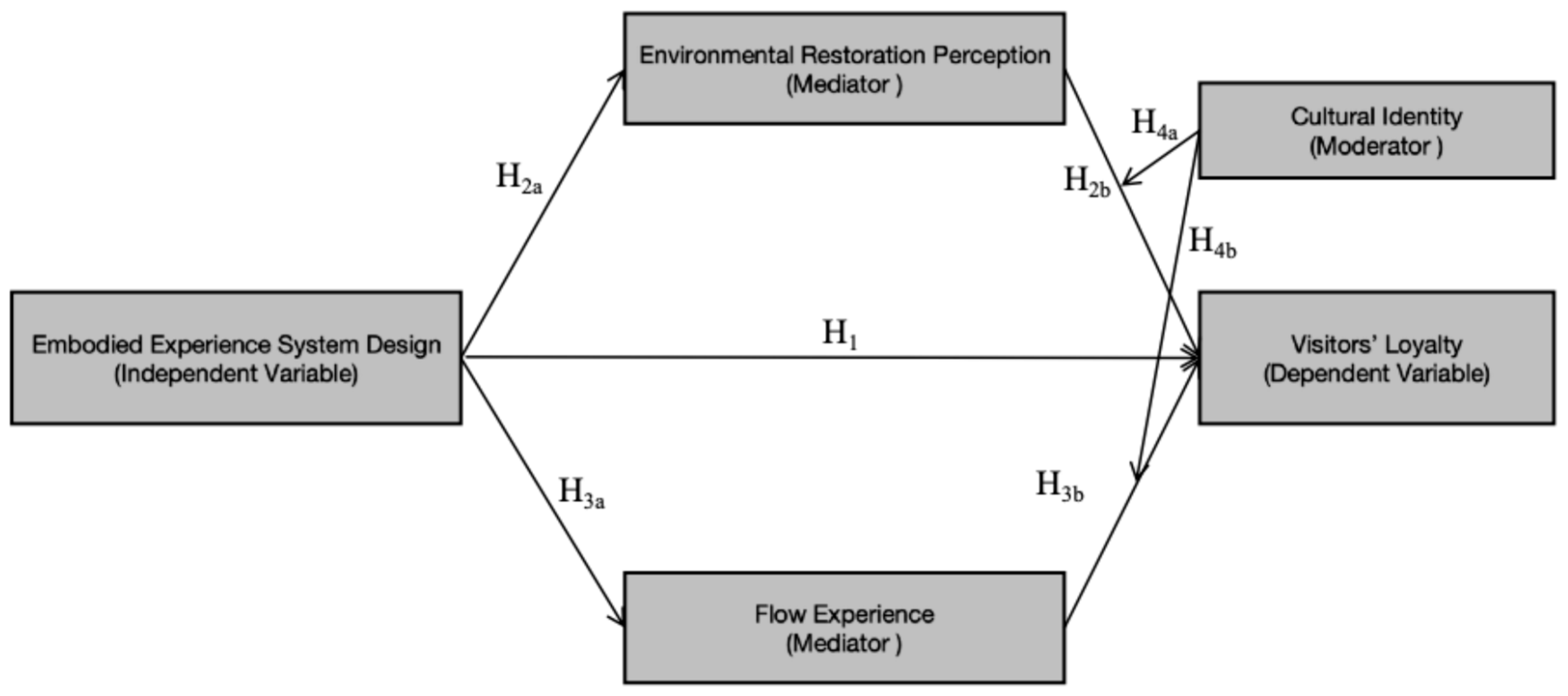
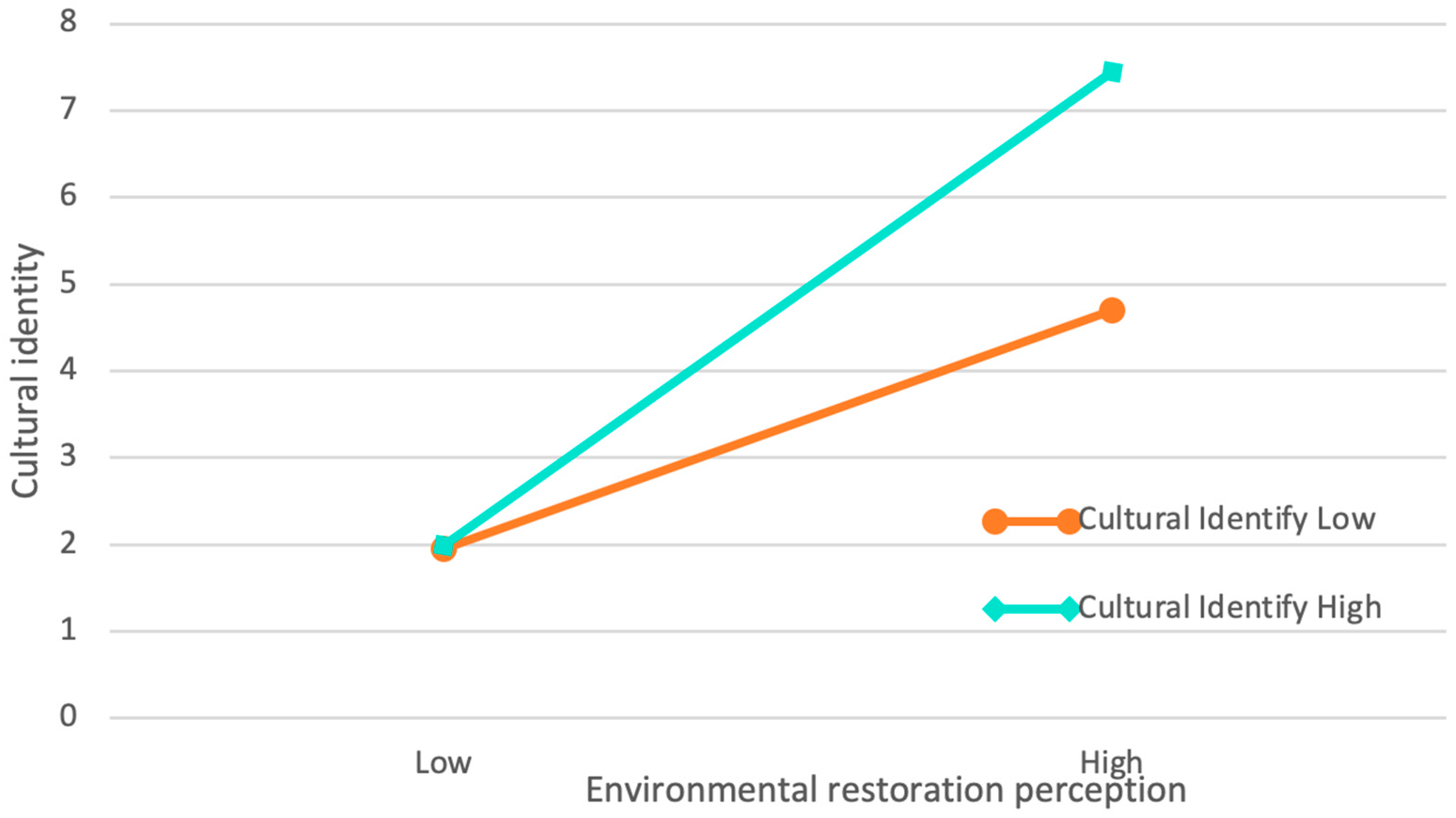
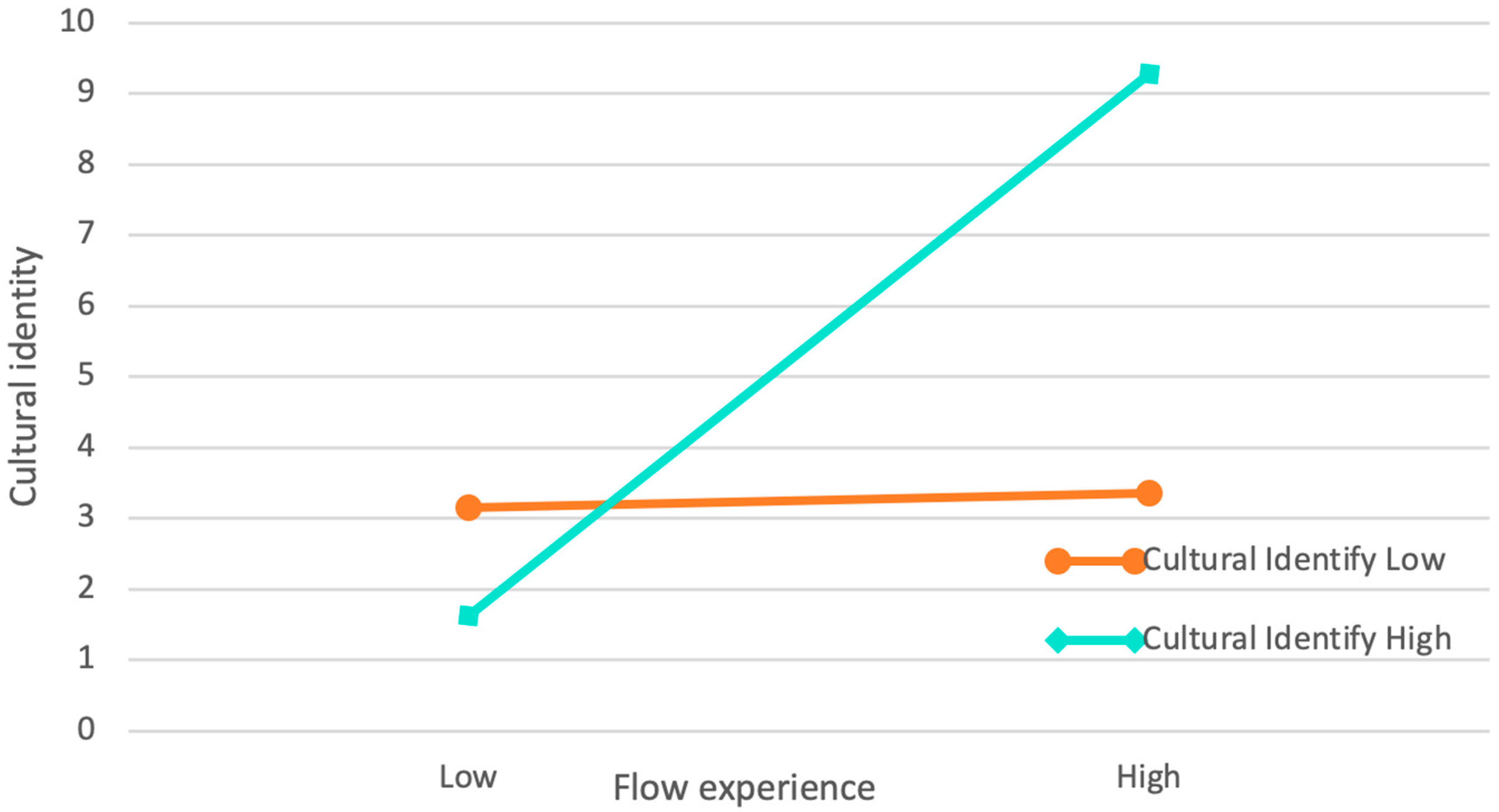
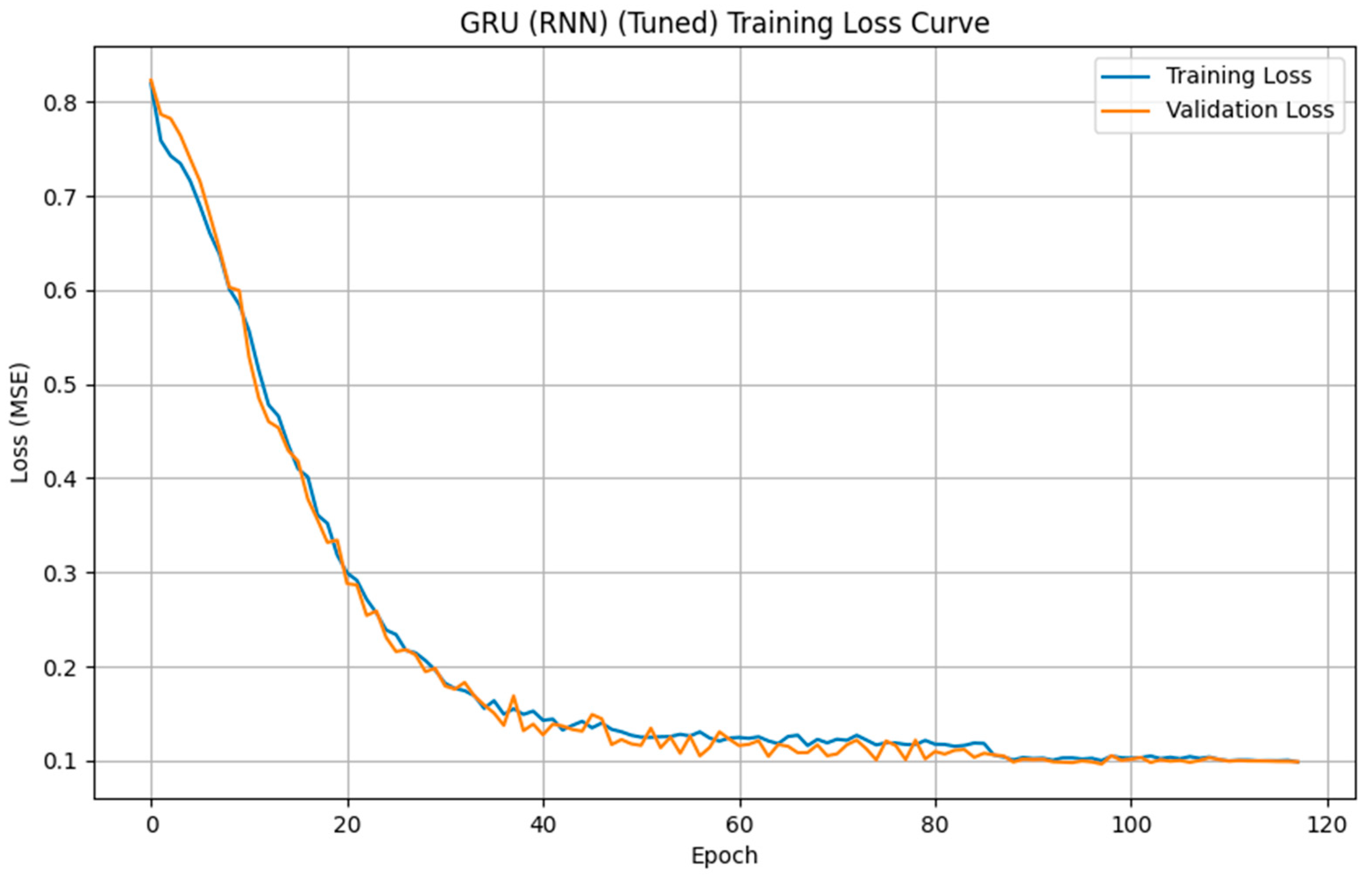
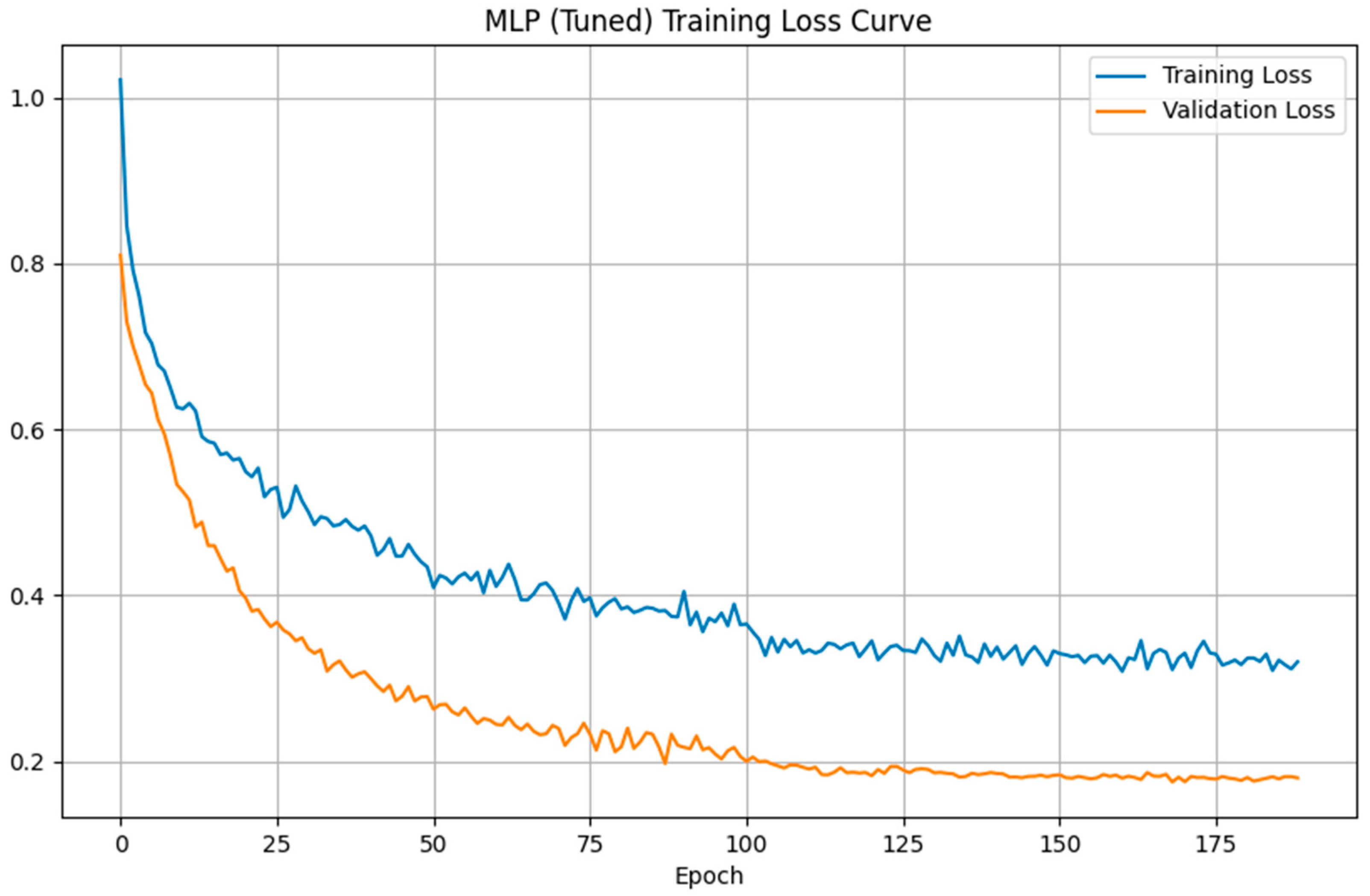

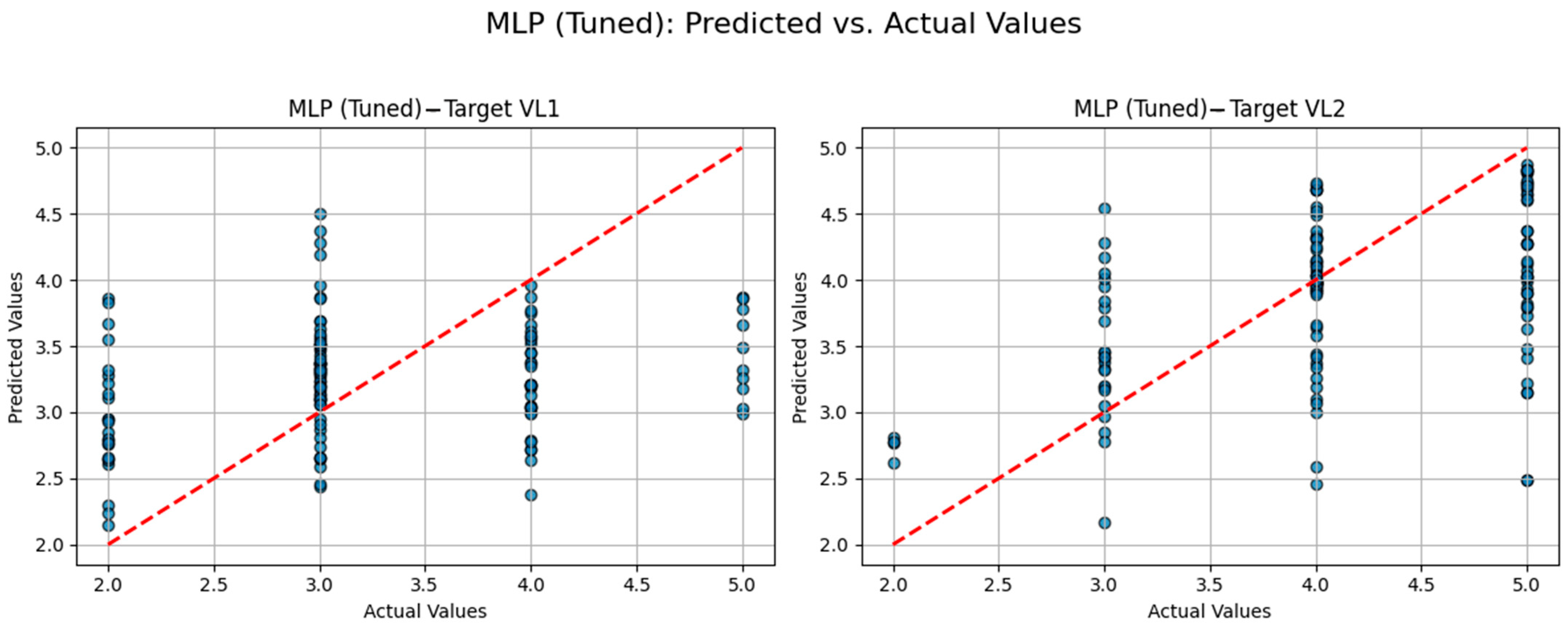

| Elements | Items | References |
|---|---|---|
| Sensory Immersion | 1. The landscape and atmosphere of the building provided me with a strong sense of visual immersion. 2. I could vividly perceive the building’s atmosphere through sounds, smells, or tactile sensations. 3. Multi-sensory experiences enhanced my memory and understanding of the building’s uniqueness. | [23] |
| Physical Interaction | 1. I actively participated in activities or interactive elements of the building. 2. Physical interaction with building elements gave me a stronger sense of presence. 3. My bodily engagement deepened my understanding of the heritage building. | [24,46] |
| Spatial Embodiment | 1. The spatial layout of the building enabled me to clearly understand its cultural context. 2. While moving through the building, I experienced coherence between scenes and narratives. 3. The spatial and environmental design enhanced my sense of place. | [21]) |
| Social and Situational Engagement | 1. During my visit, I engaged in meaningful interactions with other visitors or community members. 2. Participating in cultural or role-playing activities enhanced my sense of involvement. 3. Shared experiences with others fostered a stronger sense of belonging. | [20,47] |
| Cultural-Cognitive and Affective Connection | 1. The visit enhanced my understanding of the building’s history and cultural value. 2. I felt an emotional connection and identification with the heritage culture. 3. The experience strengthened my respect for and commitment to this cultural heritage. | [19,26] |
| Technological Mediation | 1. Digital or multimedia technologies improved my understanding of the heritage building. 2. Technology-based interactions increased my level of engagement during the visit. 3. The use of technology enhanced my immersion and interest in the heritage building. | [27] |
| Dimension | Item Count | Cronbach α |
|---|---|---|
| Embodied Experience | EE-SI 1-3 1, EE-PI 1-3 2, EE-SE 1-3 3, EE-SESI 1-3 4, EE-CCEC 1-3 5, EE-TM 1-3 6 | 0.919 |
| Environmental Restoration Perception | ERP 1-10 | 0.942 |
| Flow Experience | FE 1-6 | 0.913 |
| Cultural Identity | CI 1-7 | 0.948 |
| Visitors’ Loyalty | VL 1,2 | 0.890 |
| Model Fit Indicators | Statistical Value | Standard Value |
|---|---|---|
| CMIN/DF | 1.319 | 1–3 |
| RMR | 0.023 | 0.05 |
| GFI | 0.917 | >=0.9 |
| AGFI | 0.905 | >=0.9 |
| NFI | 0.941 | >=0.9 |
| IFI | 0.985 | >=0.9 |
| TLI | 0.984 | >=0.9 |
| CFI | 0.985 | >=0.9 |
| RMSEA | 0.026 | <=0.08 |
| Latent Variable | Observed Variables | Standardization Factor | t | p | |
|---|---|---|---|---|---|
| Environmental Restoration Perception | <--- | Embodied Experience | 0.181 | 3.641 | *** |
| Flow Experience | <--- | Embodied Experience | 0.256 | 5.038 | *** |
| Visitors’ Loyalty | <--- | Embodied Experience | 0.333 | 5.563 | *** |
| Visitors’ Loyalty | <--- | Environmental Restoration Perception | 0.183 | 3.269 | 0.001 |
| Visitors’ Loyalty | <--- | Flow Experience | 0.243 | 4.069 | *** |
| Mediation Path | Efficacy Value | Bias-Corrected 95%CI | ||
|---|---|---|---|---|
| Lower | Upper | p | ||
| EE-ER-VL | 0.028 | 0.01 | 0.056 | 0.003 |
| EE-FE-VL | 0.052 | 0.023 | 0.099 | 0.001 |
| EE-ER-FE | 0.03 | 0.009 | 0.065 | 0.006 |
| ER-FE-VL | 0.167 | 0.091 | 0.254 | 0.001 |
| Model 1 | |||||
|---|---|---|---|---|---|
| B | Standard Error | t | p | β | |
| Constant | 3.182 | 0.025 | 129.234 | 0.000 ** | - |
| Environmental Restoration Perception | 0.608 | 0.036 | 17.026 | 0.000 ** | 0.585 |
| Cultural Identity | 0.157 | 0.023 | 6.780 | 0.000 ** | 0.233 |
| Environmental Restoration Perception * Cultural Identity | 0.075 | 0.032 | 2.355 | 0.019 * | 0.080 |
| R2 | 0.439 | ||||
| Moderating of R2 | 0.435 | ||||
| F | F (3,482) = 125.489, p = 0.000 | ||||
| Model 2 | |||||
|---|---|---|---|---|---|
| B | Standard Error | t | p | β | |
| Constant | 3.542 | 0.038 | 92.953 | 0.000 ** | - |
| Flow Experience | 0.447 | 0.066 | 6.753 | 0.000 ** | 0.350 |
| Cultural Identity (fy) | 0.158 | 0.057 | 2.799 | 0.005 ** | 0.145 |
| Flow Experience * Cultural Identity (fy) | 0.207 | 0.093 | 2.223 | 0.027 * | 0.113 |
| R2 | 0.178 | ||||
| Moderating of R2 | 0.171 | ||||
| F | F (3,318) = 23.027, p = 0.000 | ||||
| Model | RMSE | R2 | MAE |
|---|---|---|---|
| MLP_Tuned | 0.8310 | 0.0027 | 0.6472 |
| GRU_Tuned | 1.0488 | −0.5999 | 0.7807 |
Disclaimer/Publisher’s Note: The statements, opinions and data contained in all publications are solely those of the individual author(s) and contributor(s) and not of MDPI and/or the editor(s). MDPI and/or the editor(s) disclaim responsibility for any injury to people or property resulting from any ideas, methods, instructions or products referred to in the content. |
© 2025 by the authors. Licensee MDPI, Basel, Switzerland. This article is an open access article distributed under the terms and conditions of the Creative Commons Attribution (CC BY) license (https://creativecommons.org/licenses/by/4.0/).
Share and Cite
Xiang, C.; Huang, Z.; Qian, J.; Rosni, N.A.B.; Ab Ghafar, N. Embodied Experience and Visitor Loyalty in Historic Cultural Heritage Buildings: Integrating Structural Equation Modeling and Deep Learning. Sustainability 2025, 17, 8379. https://doi.org/10.3390/su17188379
Xiang C, Huang Z, Qian J, Rosni NAB, Ab Ghafar N. Embodied Experience and Visitor Loyalty in Historic Cultural Heritage Buildings: Integrating Structural Equation Modeling and Deep Learning. Sustainability. 2025; 17(18):8379. https://doi.org/10.3390/su17188379
Chicago/Turabian StyleXiang, Chen, Zikun Huang, Jilei Qian, Nur Aulia Bt Rosni, and Norafida Ab Ghafar. 2025. "Embodied Experience and Visitor Loyalty in Historic Cultural Heritage Buildings: Integrating Structural Equation Modeling and Deep Learning" Sustainability 17, no. 18: 8379. https://doi.org/10.3390/su17188379
APA StyleXiang, C., Huang, Z., Qian, J., Rosni, N. A. B., & Ab Ghafar, N. (2025). Embodied Experience and Visitor Loyalty in Historic Cultural Heritage Buildings: Integrating Structural Equation Modeling and Deep Learning. Sustainability, 17(18), 8379. https://doi.org/10.3390/su17188379






